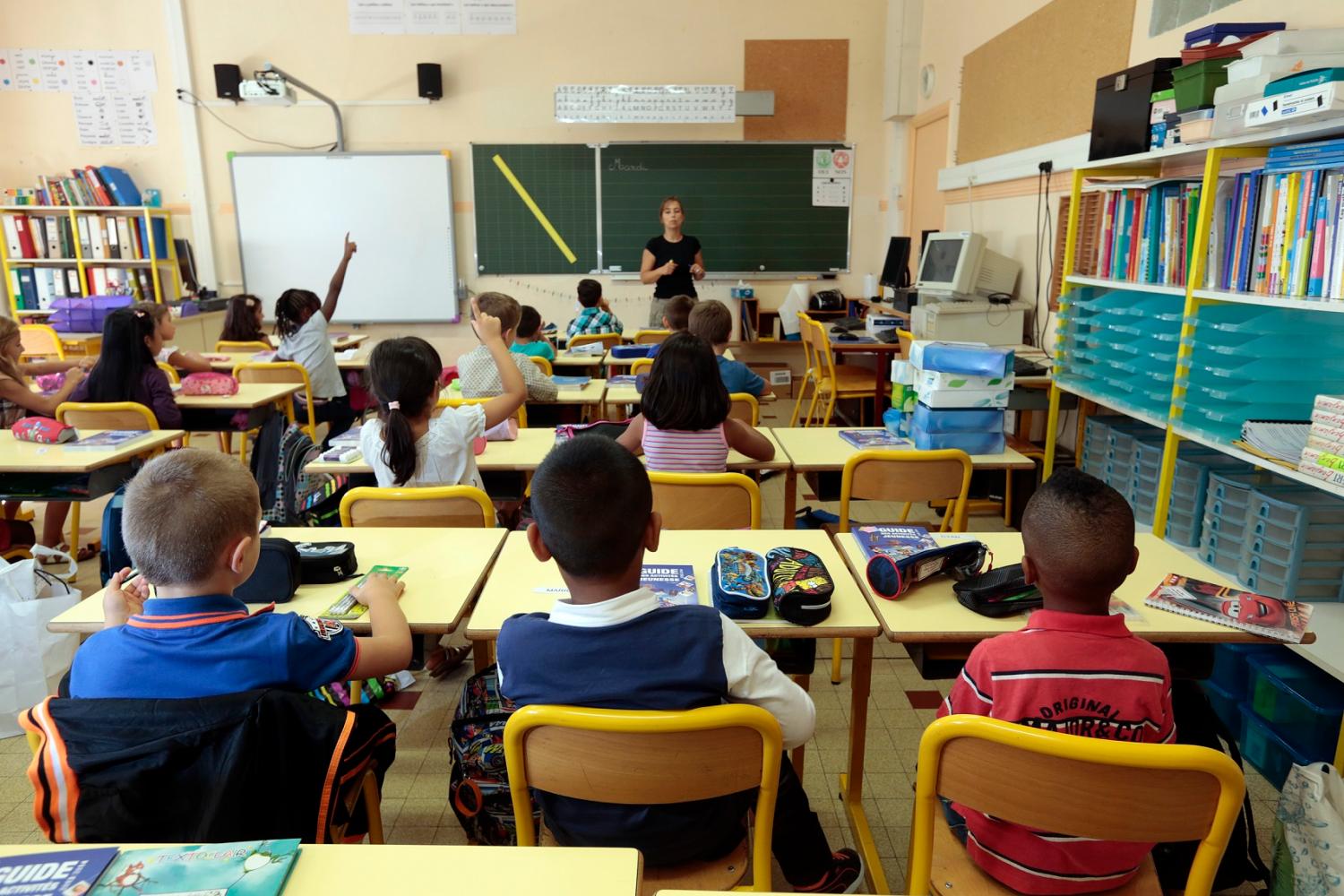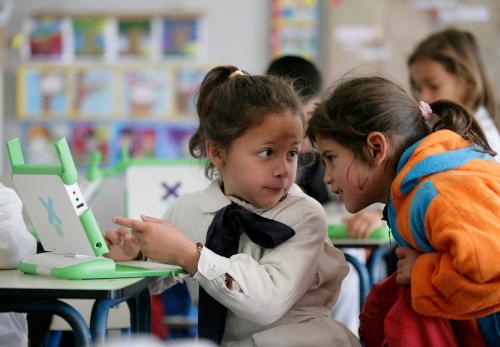A decade ago, schools nationwide were facing severe budget cuts led by declining property values during the Great Recession of 2008. This economic slowdown prompted major investments in infrastructure, including innovations in school improvement as part of the American Reinvestment and Recovery Act of 2009.
Today, we find ourselves urgently searching for strategies to help our schools navigate through another looming global economic slowdown, this time due to the COVID-19 pandemic. School and district leaders are now understandably swamped with the tasks at hand, such as satisfying the basic needs of students and staff, and engaging parents and communities to plan school reopenings in the fall. However, we must not overlook the value of more strategic investments that help build schools’ long-term capacity. If we make strategic plans now, we may have both a better chance to recover from the disruptions of student learning this spring and even harness the power of new innovations and adaptations due to the pandemic for long-term benefits.
So how do we rebuild the basic education infrastructure? In a recent paper that I coauthored with Susanna Loeb and Alec Kennedy, we examined one program funded through the American Recovery and Reinvestment Act of 2009—School Improvement Grants (SIGs). Starting in 2010, Congress invested a total of approximately $7 billion in five cohorts of SIGs. These funds typically doubled the grantee schools’ regular budget and were available for schools to use for three years. Drawing on data from four locations across the nation, which represent a geographically diverse group of states and local districts, we find that SIG program had substantial success in both short- and longer-term.
Several lessons learned from the last federal stimulus may shed light on how to rebuild and reinvest in our most disadvantaged schools and communities.
Rebuilding our school system should be regarded as an investment in upgrading the basic infrastructure of our economy.
Investing in infrastructure has been a mantra of economic recovery for decades. While roads and bridges urgently need to be rebuilt, we should not overlook investments into schools, as our education system supplies the skilled labor necessary to drive the economic recovery.
Our school system, much like our interstate highways, requires resources to upgrade its basic infrastructure. Many schools are ill-equipped with both physical and human capital. Some schools cannot swiftly provide students with laptops, stable internet, and online curriculum. On one hand, I am deeply impressed by our talented teachers who have quickly adapted to online instruction given limited resources. On the other hand, I have also observed that many educators lack training on remote learning and the best practices to engage parents to support students’ learning at home. This rebuilding of physical and human capital needs substantial resources.
Infrastructure improvement needs real investment. The American Recovery and Reinvestment Act of 2009 invested $100 billion into education, which included over $53 billion to aid local school districts, $13 billion for low-income public schoolchildren, $12.2 billion for special education support, and over $1.2 billion for educational technology, teacher salaries, and student data analysis. In contrast, the recent CARES Act only provided $30.75 billion for education in total, only half of which will be invested in stabilizing our K-12 systems.
Moreover, school improvement is a systematic process, and funding helps to ensure that happens. In our paper, we compare SIG results with prior government-driven programs that aimed to build organizational capacity to remedy underperformance in public schools. We find that SIG schools look more successful in comparison because the substantial recovery investment allowed schools to innovate and dramatically transform their infrastructure. The federal government needs to commit far more than what is allocated through the CARES Act to really make an investment in education infrastructure.
Reinvestment should encourage bold innovations that build long-term capacity of public schools.
The SIG program was not simply designed to support school operations as usual, but aimed to spur dramatic transformations in the persistently lowest-performing schools. SIG schools were asked to take some tough medicine: replacing their principals and half of the staff, adopting new curriculum and assessment, training staff, re-negotiating collective bargaining contracts with educator unions, developing new organizational structure and culture, and so forth. These bold efforts were intended to be catalysts for long-term capacity building. SIG investment also became an important investment in these typically low-income communities that were hurt the most by the 2008 recession.
Our study shows positive, gradually increasing SIG effects on student test scores during the three reform years. This gradual emergence of SIG effects highlight that capacity-building programs take time to yield impacts. The patience can pay off in the long run, as our study finds that the initial positive effects—which were particularly substantial in math and in turnaround schools—were sustained at least three years after the SIG program ended in these schools (see Figure 1). These sustainable effects are consistent with Pham et al. (2019)’s analyses of Innovation Zone schools in Tennessee that used similar reform strategies. If the stimulus programs seek sustainable social and economic benefits, it is wise to invest in innovations aimed at developing schools’ long-term capacity.
Sustainable pathways should focus on rebuilding the educator workforce, using data to drive continuous improvement cycles, and from a systemic perspective.
First, now is a critical time to rebuild our educator workforce. Compelling research evidence has highlighted the significance of teachers and principals in fostering student learning and school improvement. Talented educators make school organizations resilient to emergencies like this too. Certified teachers and principals have higher job security than many other industries due to collective bargaining. Policymakers can take advantage of the furlough and hiring freezes in other industries to recruit and retain talented individuals into education. On the flip side, without additional funding to help states and districts, the public school system will almost certainly be facing major educator layoffs next year due to state budget cuts, or voluntary exit due to increased risk and workload during the pandemic. In addition, the teacher strikes in 2018 raised awareness of how slowly states were able to start paying teachers back after the Great Recession. If we fail to support them now, we could potentially undermine the teacher workforce for the long term.
Second, we need to build educators’ data-use capacity in decision-making to promote continuous improvement. Applying computer-assisted text analysis techniques to Washington schools’ improvement planning and implementation reports, our team found several promising reform strategies that were associated with either the reduction in student absences or gains in state standardized-test scores during reform years. Those reform strategies highlight the theme of teachers and school leaders using data to inform instruction and developing targeted interventions. These data include, but are not limited to: standardized test scores; formative assessment results; staff, student, and family survey data; and classroom observations. Data analytics have transformed many industries, though we are yet to see policymakers and educators systematically use data to drive their theories of action. It is urgent that we support educators for collaboratively using data inquiries to drive iterative improvement.
Third, successful improvement needs a systemic approach. The SIG program did not just focus on one or two components; rather, it focused on all components of the basic infrastructure of school system in interaction with one another. To reiterate, this infrastructure can include the combination of educator capacity, curriculum and instruction, school leadership, collaborative school culture, and strong ties with parents and communities that truly centered on student learning. By looking at the whole system and coordinating improvement efforts across domains, SIG programs were more likely to create lasting change in schools.
Now is the time to be bold in our investment in educational infrastructure—an investment that must be substantial enough to foster sustainable improvement, rather than merely managing crisis and maintaining the status quo. These physical, human, and system infrastructures are foundational investments for our public school system, which contributes to public health and economic recovery.
The Brookings Institution is committed to quality, independence, and impact.
We are supported by a diverse array of funders. In line with our values and policies, each Brookings publication represents the sole views of its author(s).








